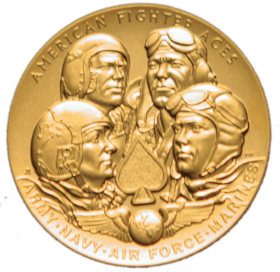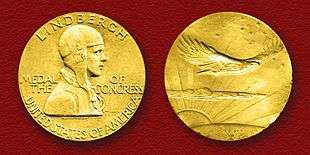Congressional Gold Medal

A Congressional Gold Medal is an award bestowed by the United States Congress; the Congressional Gold Medal and the Presidential Medal of Freedom are the highest civilian awards in the United States.[1] It is awarded to persons "who have performed an achievement that has an impact on American history and culture that is likely to be recognized as a major achievement in the recipient's field long after the achievement."[2] However, "There are no permanent statutory provisions specifically relating to the creation of Congressional Gold Medals. When a Congressional Gold Medal has been deemed appropriate, Congress has, by legislative action, provided for the creation of a medal on an ad hoc basis."[2] American citizenship is not a requirement.
History
.jpg)

Since the American Revolution, Congress has commissioned gold medals as its highest expression of national appreciation for distinguished achievements and contributions. The medal was first awarded in 1776 by the Second Continental Congress to General George Washington.[3] Although the first recipients were military figures who participated in the American Revolution, the War of 1812 and the Mexican–American War, Congress broadened the scope of the medal to include actors, authors, entertainers, musicians, pioneers in aeronautics and space, explorers, lifesavers, notables in science and medicine, athletes, humanitarians, public servants, and foreign recipients.[3] The medal is normally awarded to persons, but in 1979 the American Red Cross became the first organization to be honored with a gold medal.[2]
As of 2017 four people had been awarded more than one gold medal: Winfield Scott (1814 for the War of 1812 and 1848 for the Mexican–American War), Zachary Taylor (1846, 1847, and 1848 for the Mexican–American War), Lincoln Ellsworth (1928 and 1936 for polar exploration), and Hyman G. Rickover (1958 for the "Nuclear Navy" and 1982 for his entire career).
Process of awarding

The Gold Medal and the Presidential Medal of Freedom are generally considered to carry the same level of prestige (though significantly fewer Gold Medals have been awarded). The chief difference between the two is that the Freedom Medal is personally awarded by the President of the United States, and Congressional Gold Medals are awarded by Acts of Congress (Congress may authorize the President to present the award).
Per committee rules, legislation bestowing a Congressional Gold Medal upon a recipient must be co-sponsored by two-thirds of the membership of both the House of Representatives and the Senate before their respective committees (the House Committee on Financial Services and the Senate Committee on Banking, Housing, and Urban Affairs) will consider it.[2]

A Congressional Gold Medal is designed by the United States Mint to specifically commemorate the person and achievement for which the medal is awarded. Medals are therefore different in appearance, and there is no standard design. Congressional Gold Medals are considered non-portable, meaning that they are not meant to be worn on a uniform or other clothing, but rather displayed. In rare instances, miniature versions have been made or converted for wear on clothing, suspended from a ribbon; for Lieutenant Frank Newcomb, Lieutenant David H. Jarvis, the men of the Jeannette Expedition, the men of the First Byrd Expedition of 1928-1930, and for the men who completed the first transatlantic flight in May 1919. The latter was authorized in 1935 by Pub.L. 74–43 allowing the Secretary of the Navy to authorize—at his discretion—the wearing of commemorative or other special awards on Navy or Marine Corps uniforms, in military sized form.[4]
Often, bronze versions of the medals are struck for sale by the U.S. Mint, and may be available in both larger and smaller sizes. In at least one case, the John Wayne medal, private dealers bought large numbers of the bronze version. They were then gold plated and resold to the public for a significant profit.[5]
The Congressional Gold Medal is distinct from the Medal of Honor, a military decoration for extreme bravery in action, and from the Congressional Space Medal of Honor, presented by NASA for extraordinary accomplishment in United States space exploration.
See also
References
- ↑ Straus, Jacob R. (February 9, 2018). Congressional Gold Medals: Background, Legislative Process, and Issues for Congress (PDF). Washington, DC: Congressional Research Service. Retrieved 16 February 2018.
- 1 2 3 4 "Congressional Research Service, Congressional Gold Medals, 1776-2016 CRS Report RL30076" (PDF). Congressional Research Service. Retrieved 2017-03-01.
- 1 2 Congressional Gold Medal Recipients
- ↑


- ↑ JOHN WAYNE CONGRESSIONAL MEDAL
Further reading
External links
| Wikisource has original text related to this article: |
| Wikimedia Commons has media related to Congressional Gold Medal. |
- List of recipients
- Loubat, J. F. and Jacquemart, Jules, Illustrator, The Medallic History of the United States of America 1776–1876.